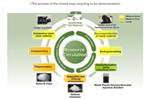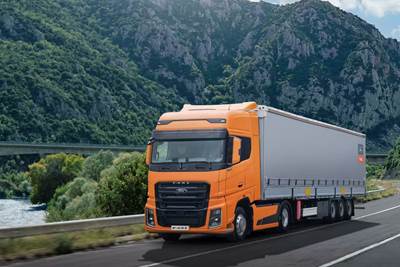Honda begins production of 2025 CR-V e:FCEV with Type 4 hydrogen tanks in U.S.
Model includes new technologies produced at Performance Manufacturing Center (PMC) in Marysville, Ohio, which is part of Honda hydrogen business strategy that includes Class 8 trucks.
A Honda associate at the Performance Manufacturing Center (PMC) in Marysville, Ohio, sub-assembles the hydrogen tanks for the all-new 2025 CR-V e:FCEV. Source | Honda
Honda (Tokyo, Japan) has started the production of its 2025 Honda CR-V e:FCEV fuel cell electric vehicle (FCEV) at its Performance Manufacturing Center (PMC) in Marysville, Ohio. The automotive company claims that it is the first production hydrogen FCEV made in the U.S. to combine a U.S.-made fuel cell system with plug-in electric vehicle (EV) charging capability; it has received a 270-mile EPA range rating, with up to 29 miles of EV driving. The compact CUV will use two Type 4 carbon fiber composite hydrogen storage tanks (read “Composites end markets: Pressure vessels”).
“The Performance Manufacturing Center was conceived as a small-volume manufacturing facility with a focus on craftsmanship, and I’m proud of how our production technicians leveraged their experience building the Acura NSX to take on the challenge of making this all-new Honda CR-V e:FCEV,” says Patrick McIntyre, lead of PMC. “Producing a zero-emission FCEV is one more step toward Honda’s global goal of achieving carbon neutrality for our products and operations.”
In addition to producing the Honda CR-V e:FCEV in the U.S., the fuel cell system that powers the vehicle is also made in the U.S. at Fuel Cell System Manufacturing LLC — the joint venture production facility established by Honda and General Motors (GM) — in Brownstown, Michigan. The fuel cell system was co-developed by Honda and GM, in an attempt to achieve higher efficiency and increased refinement, with durability performance doubled and cost reduced by two-thirds compared to the previous fuel cell system in the Honda Clarity fuel cell.
Production technicians at PMC navigated several challenges related to new production equipment and processes to effectively transition from building the Acura NSX supercar to the Honda CR-V e:FCEV. Key initiatives included:
New components: PMC technicians are taking on multiple new assembly processes specific to producing a vehicle powered by both a fuel cell system and a plug-in EV battery, requiring multiple connections for the vehicle’s two power sources and the power supply connector that can provide electrical power for various external devices. These include:
- Sub-assembly of two hydrogen tanks, attaching high-pressure piping and other parts and then installing the tanks in the vehicle
- Compressing hydrogen to 10,000 psi/700 bar via a new on-site station used to fill the CR-V e:FCEV hydrogen fuel tanks
- Installation of the fuel-cell system along with connecting high-pressure piping and wiring
- Sub-assembly and installation of the under-floor battery.
New weld system: Transitioning to the CR-V e:FCEV required a complete transformation of the Weld Department, from a highly-automated welding system created for an aluminum spaceframe to a multi-material unibody construction.
Paint system modifications: The larger and heavier all-steel body of the CR-V e:FCEV requires a different corrosion protection application process than the smaller, all-aluminum Acura NSX.
Production of the FCEV at the PMC is also laying the groundwork for production of battery-electric vehicles (BEVs) at the Honda EV Hub in Ohio.
Honda hydrogen business
Honda has identified four core domains for the use of its fuel cell system. In addition to FCEVs, the Honda hydrogen business strategy includes commercial vehicles, stationary power stations and construction machinery. Honda is engaged in collaboration with other companies in pursuit of these business opportunities.
For example, Honda recently debuted a Class 8 hydrogen fuel cell truck concept Hydrogen Fuel Cell Truck Concept powered by three Honda fuel cell systems; began a demonstration testing of a stationary fuel cell power station on its Torrance, California, campus in March 2023; and is looking at the application of its fuel cell system to equipment such as excavators and wheel loaders, which account for a large segment of the construction machinery market.
Honda says it has a vision to make BEVs and FCEVs represent 100% of its new vehicle sales by 2040. Toward this goal, Honda is establishing its “Honda EV Hub” in Ohio where the company will begin production of EVs in North America. Honda also recently announced plans to build a comprehensive EV value chain in Canada with an approximate investment of $11 billion, to strengthen its EV supply system and capability to prepare for a future increase in EV demand in North America.
Moreover, each Honda auto production facility in North America has a critical role to play in Honda’s electrified future. Even as Honda accelerates preparation for EV production, the company plans to sustain current ICE and hybrid-electric vehicle production to meet continued strong customer demand. The sales growth of ICE and hybrid-electric vehicles also will support the required investment in the electrified future.
Related Content
JEC World 2023 highlights: Recyclable resins, renewable energy solutions, award-winning automotive
CW technical editor Hannah Mason recaps some of the technology on display at JEC World, including natural, bio-based or recyclable materials solutions, innovative automotive and renewable energy components and more.
Read MorePolar Technology develops innovative solutions for hydrogen storage
Conformable “Hydrogen in a Box” prototype for compressed gas storage has been tested to 350 and 700 bar, liquid hydrogen storage is being evaluated.
Read MoreDrag-based wind turbine design for higher energy capture
Claiming significantly higher power generation capacity than traditional blades, Xenecore aims to scale up its current monocoque, fan-shaped wind blades, made via compression molded carbon fiber/epoxy with I-beam ribs and microsphere structural foam.
Read MoreComposites end markets: Energy (2024)
Composites are used widely in oil/gas, wind and other renewable energy applications. Despite market challenges, growth potential and innovation for composites continue.
Read MoreRead Next
Toray, Honda to jointly validate chemical nylon 6 recycling
Partners have begun verifying depolymerization and monomer separation and refining technologies using subcritical water for recovery of glass fiber-reinforced nylon 6 automotive parts, to be eventually broadened into other applications.
Read MoreFord Trucks chooses Hexagon Purus to equip FCEV heavy-duty truck
A purchase order for Hexagon’s Type 4 hydrogen vessels will aid in the development of an FCEV prototype per Horizon Europe’s ZEFES program decarbonizing long-haul trucks in Europe.
Read More“Structured air” TPS safeguards composite structures
Powered by an 85% air/15% pure polyimide aerogel, Blueshift’s novel material system protects structures during transient thermal events from -200°C to beyond 2400°C for rockets, battery boxes and more.
Read More

























